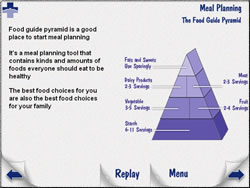Client Problem:The Diabetes Clinic was responsible for providing disease education to newly-diagnosed Type I and Type II diabetes patients. When patients came into the center, they met one-on-one with available center personnel who would guide them through sessions on basic pathophysiology, diabetes facts and fallacies, signs and symptoms, meal planning, avoiding complications, exercise, and medication. In addition to meeting with center personnel, the patient was provided brochures, pamphlets, books, and videos that described aspects of their disease. This process consumed an excessive amount of time for both center personnel and the patient, usually a total of several days per patient.
The patient profile was young children to elderly, male or female, many not having computer skills.
 Our Solution: We shadowed a Diabetes Educator for two days as they worked with newly diagnosed patients. We were then given boxes of brochures, pamphlets, books, glucose monitors, and videos that center personnel usually used for the patients. We designed and developed a computer-based learning solution that patients could complete on their own, with minimal support required by center personnel.
Our Solution: We shadowed a Diabetes Educator for two days as they worked with newly diagnosed patients. We were then given boxes of brochures, pamphlets, books, glucose monitors, and videos that center personnel usually used for the patients. We designed and developed a computer-based learning solution that patients could complete on their own, with minimal support required by center personnel.
The interface was designed to optionally use touch-screen technology for patients not familiar with using computers. The course was menu driven, allowing patients to select from topics that included all of those mentioned above. Several videos showing procedures were included that previously had to be demonstrated by center personnel.
The total program time was reduced to 5 to 8 hours, depending on the patient going through the program. It also dramatically reduced the one-on-one time required with the center personnel.
Ultimately, this course was also added to the curriculum delivered by the Center of Excellence for Medical Multimedia (CEMM) in the Division of the Air Force Medical Operations Agency.